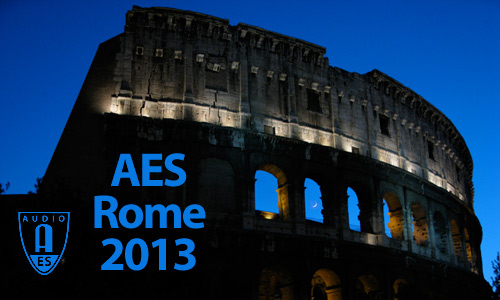
AES Rome 2013
Paper Session P1
P1 - Education and Semantic Audio
Saturday, May 4, 10:30 — 12:30 (Sala Carducci)
Chair:
Jörn Loviscach, University of Applied Sciences - Bielefeld, Germany
P1-1 Alternate Software and Pedagogical Strategies for Teaching Audio Technology to Classically Trained Music Students—Christopher J. Keyes, Hong Kong Baptist University - Kowloon, Hong Kong
Despite the many benefits, teaching audio and audio technology to music students brings as many challenges as rewards. Their vastly different scientific and technical backgrounds often require fundamentally different pedagogical strategies from other subjects in a music curriculum. The dissemination of information via lectures and/or lengthy technical readings is especially problematic. This paper addresses these challenges by presenting a new pedagogical approach centered on a free pedagogical software package: the Interactive Workshop for Audio Intelligence and Literacy (i-WAIL). When combined with inquiry-based learning approaches and projects based on the student’s area of interest, it has so far proven highly effective with music students of a wide range of previous abilities.
Convention Paper 8809 (Purchase now)
P1-2 Auditory-Visual Attention Stimulator—Adam Kupryjanow, Gdansk University of Technology - Gdansk, Poland; Lukasz Kosikowski, Gdansk University of Technology - Gdansk, Poland; Piotr Odya, Gdansk University of Technology - Gdansk, Poland; Andrzej Czyzewski, Gdansk University of Technology - Gdansk, Poland
A new approach to lateralization irregularities formation was proposed. The emphasis is put on the relationship between visual and auditory attention. In this approach hearing is stimulated using time scale modified speech, and sight is stimulated rendering the text of the currently heard speech. Moreover, displayed text is modified using several techniques, i.e., zooming, highlighting, etc. In the experimental part of the paper, results obtained for the reading comprehension training were presented. It was shown that usage of the proposed method could improve this skill in a group of children between the ages of 7 and 8 years.
Convention Paper 8810 (Purchase now)
P1-3 Evaluation of Acoustic Features for Music Emotion Recognition—Chris Baume, BBC Research and Development - London, UK
Classification of music by mood is a growing area of research with interesting applications, including navigation of large music collections. Mood classifiers are usually based on acoustic features extracted from the music, but often they are used without knowing which ones are most effective. This paper describes how 63 acoustic features were evaluated using 2,389 music tracks to determine their individual usefulness in mood classification, before using feature selection algorithms to find the optimum combination.
Convention Paper 8811 (Purchase now)
P1-4 Investigating Auditory Human-Machine Interaction: Analysis and Classification of Sounds Commonly Used by Consumer Devices—Konstantinos Drossos, Ionian University - Corfu, Greece; Rigas Kotsakis, Aristotle University of Thessaloniki - Thessaloniki, Greece; Panos Pappas, Technological Educational Institute of Ionian Islands - Lixouri, Greece; George M. Kalliris, Aristotle University of Thessaloniki - Thessaloniki, Greece; Andreas Floros, Ionian University - Corfu, Greece
Many common consumer devices use a short sound indication for declaring various modes of their functionality, such as the start and the end of their operation. This is likely to result in an intuitive auditory human-machine interaction, imputing a semantic content to the sounds used. In this paper we investigate sound patterns mapped to "Start" and "End" of operation manifestations and explore the possibility such semantics’ perception to be based either on users’ prior auditory training or on sound patterns that naturally convey appropriate information. To this aim, listening and machine learning tests were conducted. The obtained results indicate a strong relation between acoustic cues and semantics along with no need of prior knowledge for message conveyance.
Convention Paper 8812 (Purchase now)
